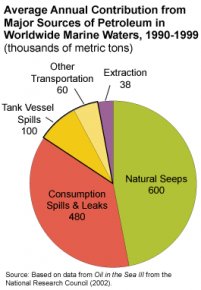Environmental Issues with oil
 Products from oil (petroleum products) help us do many things. We use them to fuel our airplanes, cars, and trucks, to heat our homes, and to make products like medicines and plastics. Even though petroleum products make life easier — finding, producing, moving, and using them can harm the environment through air and water pollution.
Products from oil (petroleum products) help us do many things. We use them to fuel our airplanes, cars, and trucks, to heat our homes, and to make products like medicines and plastics. Even though petroleum products make life easier — finding, producing, moving, and using them can harm the environment through air and water pollution.
Emissions and Byproducts Are Produced from Burning Petroleum Products
Petroleum products give off the following emissions when they are burned as fuel:
- Carbon dioxide (CO2)
- Carbon monoxide (CO)
- Sulfur dioxide (SO2)
- Nitrogen oxides (NOX) and Volatile Organic Compounds (VOC)
- Particulate matter (PM)
- Lead and various air toxics such as benzene, formaldehyde, acetaldehyde, and 1, 3-butadiene may be emitted when some types of petroleum are burned
Nearly all of these byproducts have negative impacts on the environment and human health:
- Carbon dioxide is a greenhouse gas and a source of global warming.1
- SO2 causes acid rain, which is harmful to plants and to animals that live in water, and it worsens or causes respiratory illnesses and heart diseases, particularly in children and the elderly.
- NOX and VOCs contribute to ground-level ozone, which irritates and damages the lungs.
- PM results in hazy conditions in cities and scenic areas, and, along with ozone, contributes to asthma and chronic bronchitis, especially in children and the elderly. Very small, or “fine PM” is also thought to cause emphysema and lung cancer.
- Lead can have severe health impacts, especially for children, and air toxics are known or probable carcinogens.
Laws Help Reduce Pollution from Oil
Over the years, new technologies and laws have helped to reduce problems related to petroleum products. As with any industry, the Government monitors how oil is produced, refined, stored, and sent to market to reduce the impact on the environment. Since 1990, fuels like gasoline and diesel fuel have also been improved so that they produce less pollution when we use them.
Reformulated Fuels
Because a lot of air pollution comes from cars and trucks, many environmental laws have been aimed at changing the make-up of gasoline and diesel fuel so that they produce fewer emissions. These "reformulated fuels" are much cleaner-burning than gasoline and diesel fuel were in 1990.
Technology Helps Reduce Drilling's "Footprint"
Exploring and drilling for oil may disturb land and ocean habitats. New technologies have greatly reduced the number and size of areas disturbed by drilling, sometimes called "footprints."2 Satellites, global positioning systems, remote sensing devices, and 3-D and 4-D seismic technologies make it possible to discover oil reserves while drilling fewer wells.
The use of horizontal and directional drilling makes it possible for a single well to produce oil from a much bigger area. Today's production footprints are also smaller those 30 years ago because of the development of movable drilling rigs and smaller "slimhole" drilling rigs.
When the oil in a well becomes uneconomic to produce, the well must be plugged below ground, making it hard to tell that it was ever there. As part of the "rigs-to-reefs" program, some old offshore rigs are tipped over and left on the sea floor to become artificial reefs that attract fish and other marine life. Within six months to a year after a rig is toppled, it becomes covered with barnacles, coral, sponges, clams, and other sea creatures.









